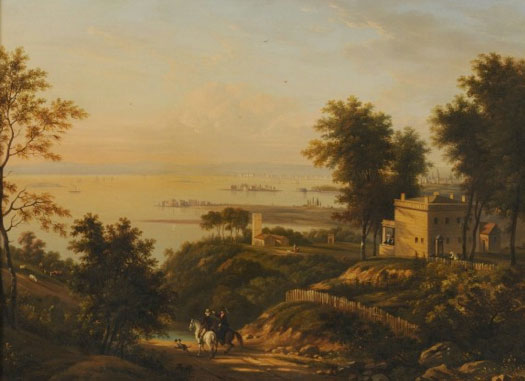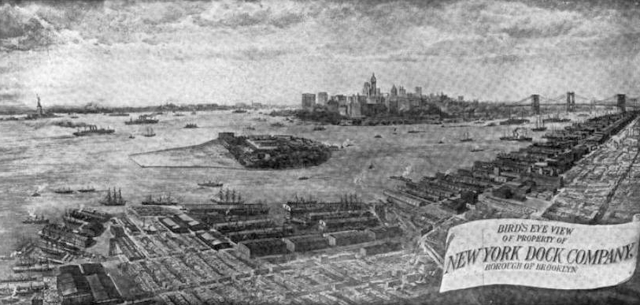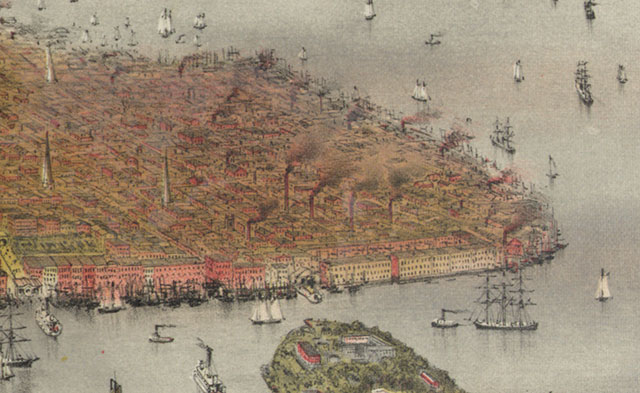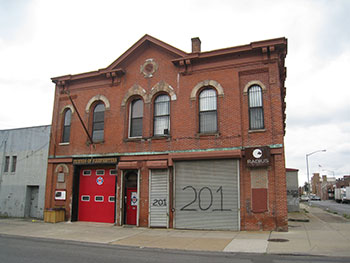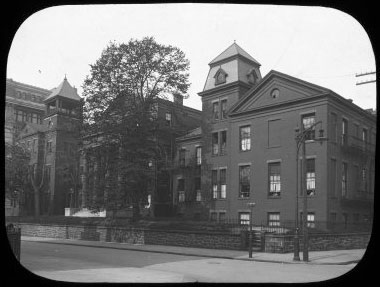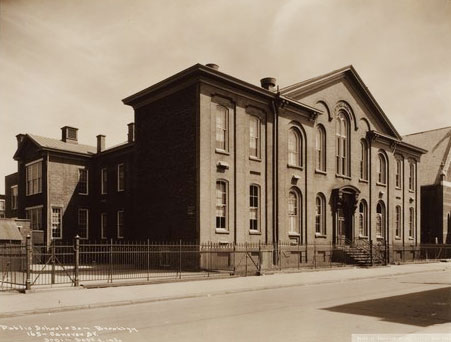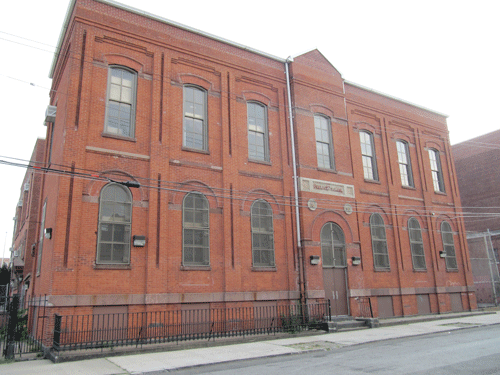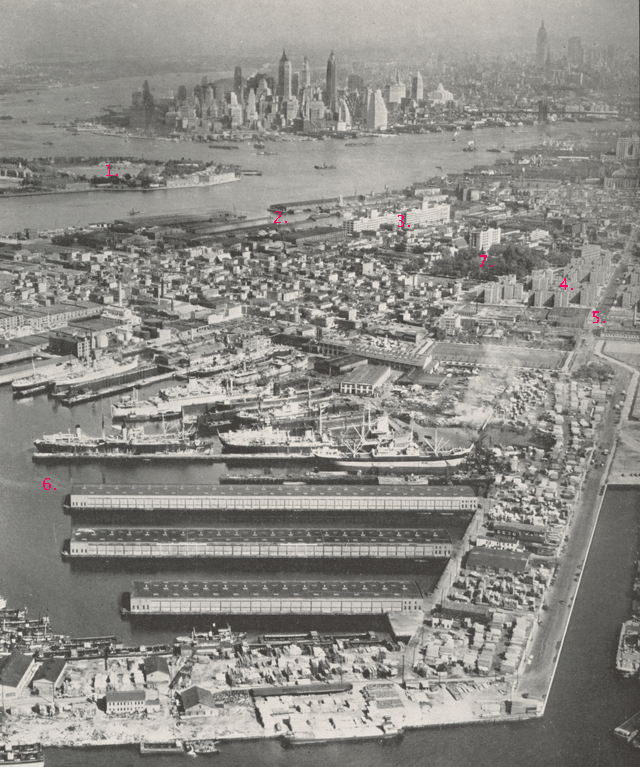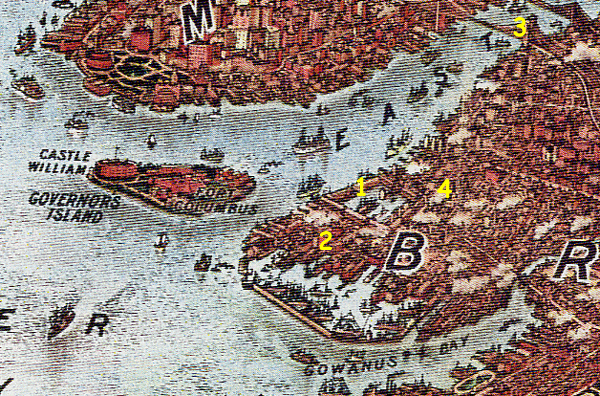Living Conditions and Health Hazards
Residential conditions in Red Hook in the mid to late 1800s must have been relatively miserable. The factories and "works" certainly exuded air pollution and noxious odors.
There seems to have been a high incidence of fires and explosions.
Work hazards were numerous and included accidents and chemical poisoning.
Chemical poisons included: White lead and phosphorus.
White lead poisoning was a danger in paint and chemical factores. Phosphorus was a danger in match factories.
Air Pollution
It was known in the 1880 that air pollution caused lung desease.
Asbestos was know to cause lung disease as early as 1898.
Two diseases are involved, asbestosis and mesothelioma. Asbestosis (a dust disease of the lungs) can only be contracted as a result of the inhalation of substantial concentrations of asbestos dust over long periods of time. (Surveyor, Volume 130 1898)
Smoke and dust were constantly in the air in many factories. By 1860 it was known that breathing dust could cause lung disease. It was an occupational hazard of malt grinding in breweries, stone grinding, flax working and charcoal making.
There was some attempt to limit air pollution.
November 17, 1899:
As requested by Mr. Hammond, I started at 8:30 a. m. for Broadway, Williamsburgh.
I saw thick black smoke in large clouds coming out from the chimneys
of these establishments:
Francis E. Frith, wood and coal, 118 Classon avenue; Johnson Bros.,
lumber, 45 Classon avenue; S. Tuttles' Son & Co., wood and coal, 596-614 Kent avenue;
Brooklyn Cooperage Co., 142 Kent avenue; Chas. Pratt Mfg. Co.,
Ryerson avenue near Kent avenue; Havemeyer & Elder Sugar Refining Co.,
Franklin avenue near Manhattan avenue; the roundhouse of the L. I. R. R. Co.,
Borden avenue, Long Island City; Standard Silica Cement Co.,
Long Island City; Chelsea Jute Mills, Manhattan avenue near
Bridge; Edward C. Smith & Co., box manufacturing, 420434 Oakland avenue;
Thos. Morgan, Manhattan avenue; Oil Seed Pressing Co., Bedford avenue;
Cheseborough Mfg. Co., Richard and Seabring streets, South Brooklyn; Casy's
Rosin Works, Richard and Delavan streets, South Brooklyn; Ph. H. Gills,
metal works, Richard and Bowne streets.
I had only about one hour to go over the South Brooklyn section
between Hamilton avenue and Erie basin. This territory has all to be
walked over, and is quite large. I saw lots of black smoke
emanating from chimneys at a distance, but did not have time left to locate them.
Twenty more violators can be easily found in this district.
Looking from Kent avenue towards the East River I saw lots of tug boats; thick black smoke coming out from their funnels.
From the Brooklyn side I saw a good many Manhattan violators.
November 18, 1899.
As instructed by Mr. Hammond, I went to-day through
South Brooklyn; covering the district between Atlantic avenue,
Third avenue, Fort Hamilton and the river, and found the following
violators of the Smoke Nuisance Law:
Roebuck's Planing Mills, 417 Hamilton avenue; John A. Casey, oil, etc.,
corner Richard and Commerce streets; Spery & Beale, mattresses, 141 King street;
D. J. McNeal, Columbia Engineering Works, William near Van Brunt streets;
Pioneer Iron Works, William near Van Brunt street; J. Hartley, machines,
69 Delavan street; Progress Machine Works, Delavan between Richard and
Van Brunt streets; Henry R. Worthington, machines, Rapelye, corner
Van Brunt street; W. H. Mairs & Co., wall papers, Sackett street
corner Van Brunt street.
These factories are, except the first named one, amidst a thickly populated district, some factories in this district ostensiblv burn hard coal.
Documents of the Assembly of the State of New York, Volume 31
By New York (State). Legislature. Assembly, 1900
Health Concerns - Malaria - the Department of Health
1873:
"Obstructed culverts and receiving basins, gutters, filthy from accumulated street manure,
and stagnant water; sidewalks unsafe for public trave, and streets filthy with
accumulated manure and garbage. " Culverts Report Health Department, City of Brooklyn,
September 1873
Specific conditions were report at specific locations: Most of the reports for Red Hook listed "filthy streets and gutters"
On the corner of Van Brunt and Van Dyke streets the sewer was obstructed.
Malaria bearing mosquitoes breed in stagnant water.
In 1895 it was reported that there were 608 medical cases
admitted to Brooklyn Hospital in 1890 - of those 18 were
malaria. No death resulted from malaria. In 1892 742 medical cases
were admitted to Brooklyn Hospital - of those 27 were malaria and
there was one death from malaria.
In 1902 there were 58 deaths
from malaria in Brooklyn whose population was 1,169,776
Noise
General noises heard by the neighborhood regardless of occupation would have included: boat whistles, fire engines, explosions, factory machinery, blast furnaces, medal works, lumber sawing, escaping steam, construction thumps,
the clop of horse's hoofs on the cobblestones, the rumble of carts and heavy wagons, squeals and whines.
In 1890 the sound of the well drill "thumped" for weeks when the India Brewing company was digging for water. A steam driven hydraulic press was used at the Merchant stores
to compress bales of cotton.
When the
the exhaust steam was blown off it made a noise that sounded
like a cross between the bellow of a bull and the scream of a tiger cat,
which could be heard for nearly two miles.
The people in the neighborhood were
furious, as the machine worked day and night
with a bellow or a scream every two minutes. One woman
is stated to have died from the noise.
The attention of the board of health was drawn to
it and it was promptly suppressed.
Brooklyn Eagle, October 1, 1891.
Some noise would have been more specifically related to occupation and place of employment. The hiss of steam machinery must have been constant in some factories.
Odor
"The foul stenches of the manure factories are greatly intensified
by the sewer gas emanations of Gowanus Canal - the receptacle of the Bond Street sewer.
Into it is poured the sewage of a large area of the densest
portion of the city; and here, in the midst of the foul emanations which poison
the air of the region, thousands of workingmen in the coal-yards, barges and
lumber-yards have to earn their daily bread. Thousands more have their
homes in the immediate vicinity, for the neighborhood is fast filling up,
notwithstanding its foulness, because men here find work, and because here
houses are cheap at the time of May* moving; and many who avail themselves of their cheapness, sadly experience the reason of it on the first setting in of hot weather."
The Sanitarian, Volume 5
By Medico-legal Society, 1877
In 1888 odors from from Vaseline and and resin factories tainted the air.
Chesebrough Vaseline works and the sugar refineries used animal charcoal which apparently had a very unpleasant odor.
Petroleum refining was malodorous.
When the park at Richards and Verona was being discussed in 1895 it was stated:
"Another disagreeable feature was the location of an oil refinery to the north of the site. It was originally started by Libby & Clark, who continued it for years, when it was purchased by its present proprietors. As a financial venture
it was and is a hugh success. As a result of odors coming from this factory numerous complaints have arisen, and petitions bearing many signatures have been sent to the city fathers."
The article further states that the oil refinery had a creek running through its
property which emptied in the Buttermilk Channel from which arose some "very bad smells".
An oil fire on Dykemman near Ferris in 1874 must have sent plumbs of foul smelling smoke into the
surrounding neighborhood.
*As crazy as it may sound, from colonial times until after World War II
May 1st was a traditional moving day in New York and other cities around the country.
Most leases were renewed as on May 1st, perhaps because
spring was viewed as a good time of year to move. Thousands of
people moved on May 1st every year!!!! See
May Moving Day
Open Sewers
In 1909 employees who worked on the East Central Pier of the Atlantic Docks
were complaining bitterly about
a sewer that emptied out under the pier.
Several men were said to have taken ill. The odor was terrible.
It was believed that the sewer came from either the India Wharf Brewing Company or
the
"molasses house" next to it.
"It is not easy to see why andy sewer should be permitted to empty
at this point, as there is a large trunk sewer on the other side of the block,
running through Hamilton avenue and discharging near the Ferry." (BE)
[emphasis mine]
Similar complaints had been made for year by employees at Pier 11, further up the line towards Brooklyn Heights.
The Chesebrough Vaseline company routinely dumped it's waste in shat is now Coffey Park.
In addition, Chesebrough oil pipes which ran
from the piers to Richards street sometimes burst spilling oil in the streets.
Heat
In the 1880s people wore more clothes than they do today.
Women wore long skirts with petticoats. There was NO air-conditioning.
There were NO refrigerators in the average home - NO way to make ice for a cold drink.
July 21, 1885 was one of the hottest day recorded in forty years.
Among the numerous people sick and dying from heat issues in July 1885 was:
"Phillip Watterson, who lives on Columbia Street, Brooklyn,
was overcome by heat while at work in the vaseline
works in Richards Street." New York Times July 22, 1885
Two cases of heat exhaustion were reported in Brooklyn on Friday August 19, 1892.
To find relief from the heat people went to the beaches in Rockaway and Coney Island.
As many as five longshoremen a day were overcome by the heat on the
Red Hook waterfront in the summer months of
July and August.
Heat affected workers in iron foundries, boiler works, glass-works, sugar refineries, and other manufacturers. Workers need to drink large quantities to replenish their body moisture. Burns were a threat.
Cold
Many working class women did not own coats. They wrapped themselves in as many
petticoats and shawls as they could find.
Men too put on layers of clothing. They would wear several pairs of pants, vests, socks, and jackets at once.
In February 1893 it was so cold in New York City that the harbor water froze to the extent that people could safely walk from the Long Dock at Erie Basin to Twenty-seventh in street in Brooklyn.
Coal powered steam heat was available in some private houses
and public buildings by 1881. It may have also heated factories. It probably did not
heat the dwellings of the working class.
Stores and saloons were heated with coal or wood burning stoves.
Work Dangers
In February 1872 Samuel McNab, laborer age 35, was severely injured when he was
struck on the
head and shoulders by a beam that fell 20 feet
from a loft at the beard's Stores. He was taken to Long Island Hospital.
As with most workers of the time he lived close to his job; In this case, at
Conover and Wolcott streets.
In September 1882 Joseph Castilano, a sailor, fell
from the foretop to the deck of the bark
Riggieri.
In February 1884 James Rogers age 49 fell from
the rigging of a vessel at Beard's Stores.
He lost consciousness and
was seriously injured in his back.
In August 1886 while hoisting bales of scrap iron
from the bark Paladin at Beard's stores James
Dowd was seriously injured
when he was struck in the head by a piece of falling iron. His wounds were
dressed and he was taken home to
118 Elizabeth Street.
In July 1890 William Caldwell of 88 1/2 Partition Street suffered internal
injuries when a bale of jute fell on him while he was working at the
Beard stores at the foot of Van Brunt street.
In September 1890 Frank Torra a longshoreman age 40
was badly scalded with steam while working
on the steamship Hampstead at the German America stores.
He lived at 42 Carroll Street. He was take to St. Peter's Hospital.
In July 1891 two men were instantly killed and several others were injured
while unloading dynamite from the tramp steamer G. R. Booth,
lying at the foot of Richards Street in Brooklyn. The dynamite was encased in wooden boxes
and the stevedores claimed that the contents were not disclosed to them by the officers
of the vessel, the head stevedore or the custom officials on the dock.
They were in the process of hoisting one of the boxes from the hold when the
explosion occurred.
The noise of the explosion, which occurred in a densely populated tenement house
neighborhood, drew a great crowd of people to the wharf, but the gates
were quickly shut and the throng was excluded (New York Times, JUly 15, 1891)
A hole was blown in the side of the ship and water poured in so rapidly the
she sank at the pier. Most of her perishable cargo had already been offloaded.
The boxes by law should have been marked as explosives.
In October 1891 Neil McCarty 56(?) years old of 11 Forth Place died
after suffering injuries
while engaged as a longshoreman at the foot of Richards street. He had been
struck in the abdomen by a barrel which was being swung from the deck of a schooner.
Deceases
There was a high instance of infectious deceases such as
Yellow fever, small pox, measles, diphtheria, typhoid fever, TB (consumption) etc. near ports.
In 1875 the New York Board of Health remarked on
cargoes coming from infected ports. Particularly noted
were cargos of cotton, rags
and hides.
The Board of Health also was concerned with the dangers posed by
ships that were coming from ports where sailors or crew may
have contacted yellow fever, small pox and other infectious deceases.
There was a check of vessels at Quarantine in the
outer harbor but the population was warned to be alert to
the spread of potentially fatal deceases that had slipped through the
quarantine check.
The most common causes of deaths among children and young adults before the advent of antibiotics and vaccinations were infectious diseases: small pox, diphtheria, typhoid fever were among the big killers.
Mosquito borne malaria was an issue in Red Hook. There were many low lying lots where water pooled and bred mosquitoes.
Case I. A robust male, aged forty-three years, living in the part of Brooklyn known as Red Hook Point, a locality noted for malarial diseases. Previous to the prodromal neuralgia he had suffered from malaise, chilliness, and other symptoms frequently seen in chronic malarial poisoning. The advent of the zoster, involving the right intercostal region, was accompanied with a severe chill, followed by fever and sweating. Temperature twelve hours after the chill 100.5.
(Transactions of the Medical Society of the State of New York
By Medical Society of the State of New York (1895)
Interestingly, it was reported that a high number of cases of malaria were contracted at Pope' Park, a recreational
area near Greenwood Cemetery that was on high ground and was a place that the Red Hook population retreated to for
some relief from the miasma of the low lying areas near the harbor.
Death and Illness in Ward 12 in 1890
WARD 12.
The total area of this ward was 756 acres, of which about 225 acres were water surface. The number of dwellings was 2,351 and the total population 27,368, making an average of 51.54 persons to the acre and 11.61 persons to each dwelling, with 4.43 dwellings to the acre.
This ward was almost entirely made land. Red Hook point being almost the central part about the original water line.
The ward was subdivided into three sanitary districts.
- Sanitary District A. - Bounded by Hamilton avenue, Van Brunt street, and New York bay. Area, 169 acres, 50 acres being water surface. Population, 6,688; number of persons to the acre, 56.20.
The original shore line in this district followed about the line of Van Brunt street as far south as Walcott street. Much of this had been filled in. The Atlantic docks and other wharves were in this district.
The buildings in this district were mostly large storehouses and factories, with some tenements.
During the 6 year period the death rate in this district was above the city average, especially for the native white of native parents. For those 15 years of age and upward, according to birthplaces of mothers, it was 9.08 for the Italians, 14.68 for the Americans, 16.48 for the Germans, and 27.15 for the Irish.
Scarlet fever, malarial fever, diphtheria and croup, diarrheal diseases, pneumonia, measles, whooping cough, childbirth, diseases of the liver, and diseases of the nervous system caused more than the average proportion of deaths.
- Sanitary District B. - Bounded by Sullivan and Bush streets, Gowanus canal, New York bay, and Van Brunt street. Area, 394 acres, of which only 219 acres were land surface. Population, 4,768; number of persons to the acre, 21.77.
This district was originally almost covered by water or within the marsh in the vicinity of Gowanus bay. The Erie basin was located in the southern portion of the district, which contained storehouses and tenements in about equal proportion.
During the 6 year period the death rate in this district was much above the city average, especially for the foreign. For those 15 years of age and upward, according to birthplaces of mothers, it was lowest for the Americans, being 10.06 as against 22.81 for the Germans and 40.31 for the Irish.
Scarlet fever, diarrheal diseases, consumption, pneumonia, measles, whooping cough, cancer and tumor, childbirth, diseases of the liver, and diseases of the urinary organs caused more than the average proportion of deaths.
-
Sanitary District C. - Bounded by Hamilton avenue, Coles street, Fourth place, Fifth street, Gowanus canal, and Bush. Sullivan, and Van Brunt streets. Area, 103 acres; population, 15,912; number of persons to the acre, 82.45.
This was a large tenement district.
During the 6 year period the death rate in this district was considerably above the city average, especially for the native white of native parents. For those 15 years of age and upward, according to birthplaces of mothers, it was 7.16 for the Scandinavians, 10.67 for the Americans, 24.86 for the Irish, and 18.63 for the Germans.
Scarlet fever, malarial fever, diphtheria and croup, diarrheal diseases, pneumonia, measles, childbirth, diseases of the nervous system, and diseases of the urinary organs caused more than the average proportion of deaths.
(Vital statistics of New York city and Brooklyn: covering a period of six ...
By United States. Census Office. 11th census, 1890, John Shaw Billings)
South Brooklyn "Garbage" Dumps
In 1886 Brooklyn paid about $675,000 for the removal of ashes. Over 260,000 loads were carted to South Brooklyn where they were deposited in
"low lots". These loads obviously included more than ash as they were the reputed hunting grounds of the South Brooklyn rag pickers. See 88 - 90 Sheriff Street, Lower East Side, Manhattan as a Microcosm of Little Germany (Kleindeutchland) for information and images of New York rag pickers.
In 1893 there were garbage dumps near the foot of
Columbia street and on Van Dyke street "several hundred acres devoted to the ashes,
kitchen refuse, and other rejected
matter brought from a large part of the City of Brooklyn." The area was a
miasma of rotting and festering matter.
Many rag pickers frequented the dump which was surrounded by shanties inhabited
mostly "by Irish". Although the keeping of pigs was forbidden in Brooklyn at the time,
hundreds of hogs roamed "over the dumps and feast to their hearts content off the dead animals and carrion
which find its way there." Goats were also plentiful. And chickens abounded.
In 1895 the Brooklyn garbage dumps were reaching capacity.
Proposals were afoot to dump the garbage at sea. By 1890
New York City had been dumping their garbage at sea for some time as low lots in need of fill
were getting harder and harder to find.
But in 1895 the Brooklyn dumps still
provided employment for a number of people who collected empty
tin cans and resold them "by the hundreds" to medal dealer who recycled it.
In 1890 the Brooklyn dump was bounded by Court street, Dwight street, Bush street and the Gowanus canal.
At one time this area had been under water. It had steadily been filled in with "garbage".
The waste was collected from homes and factories and carted to the dump by horse drawn wagons.
Technically it did not contain garbage (waste from food - which was fed to pigs) but mainly ashes
and non degradable items.
Old Men, women and girls and boys sifted the ashes for any pieces of coal that might be usable for fuel.
Pieces of wood from broken crates, barrels and cigar boxes were retrieved.
Old shoes were cut apart to recycle the leather to shoe repairmen.
Pieces of iron, tin cans and bottles were collected. Many "tin" cans were made of tin, solder and iron.
When burned in a hot fire the components could be separated and the iron sold.
The dump was mainly the domain of the Irish who often squatted
on the land in shanties constructed from
the scavenge of the dumps. In 1890 there were about twenty five or thirty of such dwellings.
Frederick Klineau, a rag picker, born in Prussia circa 1815 lived near Columbia and Lorraine in 1860.
White Lead
White lead poisoning was a devastating condition suffered by many people who worked in lead paint factories.
There were at least two paint factories in Red Hook in 1869: J. A. H Bell and Willis and son. J. A. H. Bell's paint was
made with white lead. Manhattan Chemical also used white lead; they were sued in a white lead claim in Jan 1881.
White lead paint was made with "white lead" (lead carbonate PbCO3) and linseed oil. Turpentine or benzine could be added to
increase the fluidity and allow for a smoother finish.
Workers in the white lead paint factories suffered from stomach complaints and
convulsions; sometimes resulting in death.
The children of women who worked in white lead factories were frequently born premature and often died from convulsions at a young age.
White lead was known to be poisonous as early as the 1802.
Its association with painters and white lead factory workers was recognized at least as early as 1810.
"White lead, one of the most dangerous preparations of this article, is very largely used in the arts, especially as a paint. Its color and appearance are well known. It is most productive of disease to those who manufasture it, and to painters. Those who labor long in lead factories, become pale and sickly, and subject to colic of a peculiar and dangerous kind; to be described presently. We have had an ample opportunity to witness the terrible consequences of working in lead factories, in the southern part of this city. - Those who, by reason of a strong constitution, escape colic for the time, are apt, sooner or later, to be attacked with palsy.
The sufferings, however, of painters, potters, glass-makers, &c., from the fumes of white lead, or from working in it and handling it continually, are more certain, if possible, than of those who only manufacture it. So commonly are painters subject to colic from this cause, that the peculiar form of their disease has given rise in England and other countries to the name of painter's colic. The character which this dreadful disease puts ou, making proper allowance for the age, constitution and habits, and other diseases of the person attacked is in general as follows:
It begins with short attacks of colic pains,
I which become more mid more frequent, of longer duration, and
of greater severity - so great indeed as to be almost insupportable.
The mouth is very dry; there is a frequent inclination to vomit; and
sometimes the vomiting becomes violent. Joined to these symptoms is a
most violent constipation of the bowels. The intestines themselves appear
to be so convulsed or cramped that nothing will pass; and indeed the very
muscles in this part of the body are sometimes drawn into hard knots or
lumps, and the whole region of the bowels becomes excessively painful to the
touch. When the disease has reached this stage, if it is not speedily relieved,
the spasms and pain becomes more and more insupportable; the costiveness
become wholly unmanageable; the intestines become inflamed, and the
bowels gangrenous, or, as we commonly say, mortified; and death ensues
as a matter of course."
- Healthside Vol 8 page 86 From Alcotts Library of Health DOMESTIC POISONS
In 1827 the symptoms were described as follows:
"The symptoms which preparations of lead produce are
obstinate costiveness, pain in the stomach, and vomiting;
the pulse becomes small and hard; the respiration laborious
and tremors ending in paralysis of the extremities, or death,
ensue, when its operation is not counteracted by medicine.
The exhibition of cathartics combined with opium or henbane,
plentiful dilutions with mucilaginous liquids, the warm bath,
and injecting mutton broth per anum, are the best antidotes."(The Eclectic and general dispensatory: comprehending a system of pharmacy ...
By American physician) 1827
And again in 1838
"White lead is the basis of most of the paints commonly employed, and as it affects the human frame injuriously through the lungs and the skin, as well as when taken into the stomach, we often find manufacturers of white lead, plumbers, and painters, who are all much exposed to the fumes or emanations of white lead, and also to contact with it in the preparation and the use of their paints, seriously and sometimes fatally affected with the disease called painter's colic. The symptoms of this disease are frequent recurrence of colicky pains, at first slight, hut afterwards intensely severe, with dry mouth, sickness, and vomiting of bitter matter of a dark green or almost black colour. Pains in various other parts are also very common, as in the arms and legs; and occasional sensations of numbness and muscular feebleness alternate with the pains. The bowels are usually costive, and the excrement is passed in hard round pellets, like that of sheep. To these symptoms succeed in most cases, sooner or later, either apoplexy, or partial palsy, particularly of the arms and hands, with a wasting of the flesh. The disease is frequent amongst painters, plumbers, lead smelters, colour makers, and other artisans, whose business leads them either to constant exposure to the fumes, or constant handling of lead in any of its preparations; and the same symptoms are the consequence of the protracted use of wine, cyder, or any article of food that is impregnated with this metal.
Should you ever he called to a person labouring under
a sudden attack of painter's colic, you must resort
immediately to purgatives and anodynes in full doses;
an ounce or more of Epsom salts, or an ounce and a half of
castor oil in the first place, and a quarter of an hour afterwards
a small tea-spoonful of laudanum; but should the salts or the oil be
rejected, give the laudanum immediately, and repeat the purgative in half an hour."
The village pastor's surgical and medical guide: in letters from an old ...
By Fenwick Skrimshire
White lead poisoning and its association with painters and paint factory workers was widely reported in medical literature through the 1830s, 1840, 50s, 60's and 70's. The excepts above are just a small sampling of the coverage white lead poisoning got in the medical press.
In 1877 in Popular Science the pros and cons of white lead were succinctly spelled out:
"White-lead, as a pigment, is chiefly valued for its "body", and for the ease
with which it is laid on; but it produces lead-poisoning and tend to lose its whiteness."
In 1875, Charles Dickens' The Uncommercial Traveller contained a short story ' A Small Star in the East' in which a woman who worked in the lead paint factory is described:
"It was not until I had spoken with the woman a few minutes, that I saw a horrible brown heap on the floor in a corner, which, but for previous experience in this dismal wise, I might not have suspected to be 'the bed.' There was something thrown upon it; and I asked what that was.
"Tis the poor craythur that stays here, sur; and 'tis very bad she is, and 'tis very bad she's been this long time, and 'tis better she'll never be, and 'tis slape she does all day, and 'tis wake she does all night, and 'tis the lead, sur.'
'The what?'
'The lead, sur. Sure 'tis the lead-mills, where the women gets took on at eighteen-pence a day, sur, when they makes application early enough, and is lucky and wanted; and 'tis lead-pisoned she is, sur, and some of them gets lead-pisoned soon, and some of them gets lead-pisoned later, and some, but not many, niver; and 'tis all according to the constitooshun, sur, and some constitooshuns is strong, and some is weak; and her constitooshun is lead-pisoned, bad as can be, sur; and her brain is coming out at her ear, and it hurts her dreadful; and that's what it is, and niver no more, and niver no less, sur.'
The sick young woman moaning here, the speaker bent over her, took a bandage from her head, and threw open a back door to let in the daylight upon it, from the smallest and most miserable backyard I ever saw.
'That's what cooms from her, sur, being lead-pisoned; and it cooms from her night and day, the poor, sick craythur; and the pain of it is dreadful;"
In 1879 painters' colic was again described inA treatise on chemistry ...
By Henry Enfield Roscoe, Carl Schorlemmer
"painters' colic is the chronic from of poisoning by carbonate of lead. The symptoms of chronic lead poisoning are pain in the abdomen,
constipation, loss of appetite, thirst, and general emaciation followed
by nervous prostration known as lead-palsy, epileptic fits, and total paralysis.
A very characteristic phenomenon accompanying chronic lead
poisoning is the appearance of a blue line at the edges of the gums
due to the deposition of lead sulphide. This line is often
seen in the case of house-painters and the workmen engaged in white-lead works.
While the danger of white lead paint were known in the medical community it is not clear when the
painters and paint factory worker may have become aware of its danger. In 1852 an article in the New York daily Tribune discussed the dangers of white lead paint.
In 1879 the New York Times ran an article on painters colic and the
effects of lead poisoning.
It was recognized in the popular press in the 1870s and 1880s that cosmetics containing white lead were injurious to ones health.
In a 1870 article in the Brooklyn Eagle Augustus Graham is credited with the development of the "buckle" method of preparing the white lead: "The process of molding is greatly shortened, and all handling dispensed with.
This is an great gain in point of heath, as too much handling is extremely injurious to the workmen." While this reduced the actual touching of the lead the process was further described as putting the lead buckles in pots of vinegar or acetic acid which produced noxious "vapors". After a rather complicate curing process portions of pure lead are left in the pots. These are remelted, re-oxidized, washed, ground and dried. Then it is washed and ground again. Finally it is ground with oil. It is then ready for market. In 1870 there were reportedly five or six white lead factories in Brooklyn.
In 1881 Isaac Brown sued the Manhattan chemical company for $25,000 in damages
for injuries suffered from white lead poisoning. I have not been able to find the outcome of this case. The Manhattan Chemical was selling white lead for only 8 cents a pound in November 1869.
White lead poisoning connected with paint was recognized as a health issue in the Brooklyn Eagle in1870, 1882, 1885, 1886 and 1897.
In 1886 it was stated that the highest death rate per occupation was from lead poisoning
common in plumbers painters and filemakers.
White lead poisoning and the dangers it posed to house painters and paint factory workers was widely written about in the popular press in the 1880s and 1890s.
In the 10 years between 1883 and 1893, and estimated 1,043 people died of lead poisoning in
England and Wales - 831 males and 209 females. Most of them worked in white lead factories.
In 1887 the output of white lead in the United States was estimated at 65,000 tons.
White Zinc Paints was introduced in the US in 1849 by the New Jersey Zinc company. It advertised as "one third cheaper than
White Lead and Free from all poisonous qualities." Clearly there was an alternative to white lead paint from the mid 1800s.
Mr. Collins, the practical painter, who is the foreman of painters in this Navy Yard, tells me that it is his opinion that the white Zinc paint is far preferable to white Lead paint. (Reports of the New Jersey Zinc Company, 1852 - Page 32)
It was claimed that white zinc was cheaper, more durable and had a beautiful finish.
The advantages of white lead paint were its ease of application and its enormous covering property.
Zinc white is still in use for residential painting.
Lead white was banned for residential use in 1978. It is still used for highway markings and such industrial uses as bridge painting.
Zinc White
Match Factories
There were at least two match factories in Red Hook in the mid 1800s: William H Rogers at Delevan and Columbia and Willis & son at 57 Seabring St.
In addition to the obvious danger of fire, workers at match factories in the mid to late 1800s were exposed to phosphorus and other chemicals.
- Workers suffered chemical burns.
- Effects of phosphorus fumes caused nausea and stomach complaints.
-
Long term phosphorus exposure caused phosphorus necrosis - a kind of rotting of the teeth, jaw and other bones.
There was
a condition known as Phossy jaw:
"caused by chronic occupation-related poisoning by elemental or yellow phosphorus which causes mandibular necrosis, in particular in factories producing yellow/white phosporus-based matches"
(Segen's Medical Dictionary. ©2012 Farlex, Inc.). Phossy jaw was potentially an extremely disfiguring disease. This condition was know in the mid 1800s, with cases reported in connection with working at match factories as early as 1860.
Poisoning by phosphorus has become so frequent in consequence of the universal introduction of chemical matches...." (Nov 22, 1860 BE)
It usually appear after the worker had been employed in the factory for four or five years. 10% to 12% of the workers became effected.
Phosphorus matches, called "lucifer matches" could be struck on any rough surface. They were invented in England in the 1830s. In addition to being toxic they were a fire hazard. The manufacture of
phosphorus matches was gradually banned in the United States. They were replaced with "safety matches" which need a special stip to ignite the match. Safety matches were invented in Sweden in 1855. In 1910 the Diamond Match company patented the first nonpoisonous match in the United States.
- Children were frequently employed in phosphorus match factories to pack the matches in boxes. Women were employed to sort the matches. Men were employed to dip the matches in the phosphorous.
A fire in a match factory in the Bush Building in South Brooklyn indicates that there were sprinkle systems in use by 1915.
Industrial Waste
Rivers and creeks were basically used as a dumps. In Newtown Creek, which separates Brooklyn from Queens the situation was so bad that the river sludge dumped by Standard Oil company actually caught on fire in 1884.
Sludge acid and sludge tar, byproducts of oil refining, produced "foul and far reaching stenches". These and other byproducts of industrial Brooklyn were thrown on the ground and dumped in the river, canal, sewers and drains. Not only did this smell, it killed the fish and other wildlife and deprived the local population of a place to swim.
The Gowanus Canal which forms the eastern boundary
of Red Hook is currently a EPA Superfund site.
In 1899 the Parks Commission reported on Red Hook Park. The park included a "shelter" house, toilet and fountain.
"In order to construct this park, aside from the planting, it was necessary to cart away over 13,000 cubic yards of ashes and other foreign materials, and to place there 20,000 cubic yards of top-soil and dressing."
Loss of Job to Illness and/or Injury
If a person was injured on the job they were more or less out of luck. There was little or no financial or other assistance for injured workmen in the United States before the end of the 1890s. If the injured workmen could prove that his injury was totally the
responsibility of his employe he could sue for damages.
Seasonal and Other Periods of Unemployment
In the winter of 1893 the Brooklyn Eagle reported "hard times" and major unemployment and called Red Hook one of the poorest districts in the city with hundreds of people who were willing to work but could not find jobs. The pastor of Visitation church said that most of the people living in Red Hook were
"of the laboring classes". Lidgerwood Manufacturing was said to be on the verge of closing "which would throw 500 men out of work".
Wages at the "hydraulic works" had been cut and the "men were working half time". The Vaseline works and the stone works were "running on short time".
Shipping was down. The only sector said to have been doing well in the previous months were the canal boatmen.
The canal boats plied there way between New York City (including Brooklyn and New Jersey). They were towed by
tug
to the Erie Canal at Albany. From Albany they were towed by mules along the Erie
Canal to Buffalo. As winter approached they left their mules in Albany and were towed to New York.
Many canal boatmen and their families spent the winter tied up in the Erie Basin in Red Hook.
In April 1886 when Marie Sophia Kettler was not quite 2 months old the Brooklyn longshoremen went on strike.
About 2,500 longshoremen were dissatisfied with their wages which were 20cents an hour. The problem was not the wages per se but the
number of hours worked which might be only three or four house per day. The longshoremen were asking for 25 cents per hour and 30 cents an hour for work done after 6 o'clock at night.
The longshoremen removed merchandise from the vessels.
Other workers called storemen worked inside the warehouses.
Discomforts at home
Most people did not have running water. Cold water flats were the norm.
Most residences and workers in Red Hook in late 1800s probably used an outhouse or a privy.
There was no central heating or AC. Most people
did not have electric lighting. Oil lamps, kerosine lamps and gas lighting
were smelly and dangerous.
1881: A 47 year old woman attempting to light a fire in her rooms with kerosene oil
was burned on her head and body when the can holding the kerosene exploded splattering the burning liquid all over her.
Another kerosene related accident occurred at 83 Ferris street when a 12 year old girl attempted to light a kerosene fire with a match.
The kerosene can exploded covering the girl with burning flames. She died a few hours later from her burns.
A third incident resulted in a mother and her 17 year old daughter being burned around the head and hands
when a kerosene can exploded as they
attempted to light a fire.
A women was burned when her clothes caught on fire while she was near the kitchen range.
These are just a few of the hundreds of kerosene related accidents causing burns, disfiguration and death.
In 1893 a 73 year old woman at 83 Ferris
Street
died of burns when her lamp exploded in her apartment.
Discomforts at Work
Work hours were long in the mid to late 1800s. Thirteen hour days were common and 18 hour shifts were not unheard of. In winter this certainly indicated working while it was dark outside.
Gas lighting was popular in homes and factories in the late 1800s.
With the advent of gas lighting in factories work hours were extended and many factories operated 24 hours a day.
There were two dangers connected with gas lighting: contamination of the air (in other words it smelled bad) and carbon monoxide poisoning. The quality of the light was not great, especially when compared to today's standards.
In 1894 it was noted that it was difficult to examine dry goods under artificial light if the day was gloomy.
Electric lighting "apparatus" was advertised in the Brooklyn Eagle in 1883. Early use of electric lighting was pretty much confined to street lights and trams.
The first electric power plant in the New York area opened in Manhattan in 1882.
As early as 1898 electric lighting was available in some houses in Brooklyn. As late as 1901 Gas Light stock was advertised in the Brooklyn Eagle as "the brightest, cheapest and most powerful Artificial Light in the world." Homes and factories were converted to electricity in the US between 1901 and 1940.
Interestingly, incandescent electric lights were used on passengers ships before 1884.
They were powered by horizontal steam engine dynamos.
Early Electrical Lighting in Homes
By Steve O'Bannon, steve@rexophone.com Cool site with a lot of images relating to early electric lighting.
Street Dangers
Runaway horse wagons were an ever-present danger. The news papers were filled with stories of
injuries incurred by out of control horses and wagons. Ice wagons and Brewery wagons seemed to be major culprits.
In 1851 improvements were being made on Dikeman street. Carts engaged in "filling in" ran over
a neighborhood boy. He was so severely injured that he was not expected to live.
A few days earlier another boy suffered a fractured thigh bone by "being run over
with one of these same carts."
In 1902 a woman and and her six month old babe in arms were
knocked down and badly bruised by a team of out of control horses from the India Wharf
Brewery.
In 1905 Pat Moran a driver for the India Wharf Brewing co.
left his horses parked while he went into a saloon to deliver a keg of beer.
The horses became spooked and ran. To avoid running down a crowd of children
playing in the street the animals crashed onto the sidewalk, breaking the
glass windows of two stores.
The horses were cut, but the children were fine.
In 1905 Walter Gill age 20 was "brushed" to the pavement when he attempted to stop
a team of runaway horses pulling a
India Wharf wagon. Before the team could be stopped the hub of one wheel
tore away a tree box in front of one store and tore the awing off another.
Gill needed to go to the hospital and the team driver was arrested for
leaving his team unattended.
In 1907 a team of horse pulling an India Wharf Brewery wagon were spooked and ran away.
The horse ran for several blocks before their "mad pace was checked" by the driver.
Fortunately,
no one was hurt. However, before the driver could get them under control,
the crashed into a grocery delivery wagon which topled over and the grocery wagon
horse also ran away - to be stopped several blocks away.
Fire
Large and small fires were an ever present danger.
House Flies
With the advent of the widespread use of electricity, including the concept of the electric motor to propel vehicles, it was speculated that the house fly would disappear.
House flies to Disappear
"That this industrious and exceedingly persistant pest is a product of the horse stable is so well settled as to be beyond controversy. If there are no stables in the city
and no horses on the streets there will be no flies. (BE, December 30, 1900)
Child Labor
In many working class families both husband and wife would work until children were born. Then the wife/mother would stop working. The mother/wife may take in piece work or the family may live with parents or take in boarders to make ends meet until the children were old enough to join the work force and contribute to the family income.
Young boys worked as boot blacks, newsies, messenger boys and delivery boys. Young boys also worked in factories, especially in the shoe, paper, glass, weaving, lumber and tobacco industries. Young women were frequently employed in match factories, box factories, the garment trade and artificial flower making.
The Case of Frank Wiegel"
Frank Wiegel, age 15, of Brooklyn was injured when he fell asleep at a machine in the Henry Bosch
wallpaper factory while working an 18 hour day. His injury occurred near two o'clock on a Sunday
morning 17 hours and 55 minutes into an 18 hour shift. Through his mother and guardian, Anna Wiegel Dolan,
he sued the company for damages and was awarded $10,000 - $5,000 for each of the two fingers he lost.
A child with a factory job could work 12 to 18 hour days six days a week.
In November 1892 F. Wiegel, 756 Third Ave advertised in the Brooklyn Eagle
for a position as a house keeper. She listed herself as a "North German widow". The Wiegel family was listed in the 1892 state census: Fredrick age 40, Louisa age 40 and Fredrick age 14 in Ward 8.
In 1900 the Wiegel family at 756 Third Ave Brooklyn Ward 8, Kings, New York included:
Wieger Fredrick, Head, Apr 1852, age 48, Married 25 years, born Germany immigrated 1866,
Wieger, Louisa, Wife Oct 1854, age 45, Married 25, born Germany immigrated 1868
Wieger Fredrick A, Son Jul 1876 age 23, Married 3 born New York
Wieger, Annie, Daughter in Law Aug 1877 age 22 Married 3,
Wieger, Louis H, Grand Son, Mar 1900 2/12 (Could this be "Frank"?)
1910 Census 756 Third Avenue Ward 8: William J Dolen 46, machinist machine shop,
Anna Dolen 31,
Frank "Dolen" 12,
William J Dolen Jr. 5,
James E Dolen 2,
Cornelius A Dolen 2/12,
Cornelius Dolen 36, brother, laborer odd jobs.
1915 Census New York: 3rd Ave Brooklyn, W J Dolan 42, machinist,
Anna Dolan 38,
Frank Dolan* 16, paper handler,
W J Dolan 11,
James Dolan 7,
Conelius Dolan 5,
Margaret Dolan 4,
Richard Dolan 1,
Frances Diga 19, sister in law, machine hand.
* although the name is given as "Dolan" this must be Frank Wiegel.
1920 Census Brooklyn: Brooklyn Assembly District 3, Kings, New York - 3rd Ave.
William J Dolan 54, boiler make machine shop,
Anna Dolan 42, born Berlin,
William J Dolan 15,
James E Dolan 12,
Cornelius Dolan 9,
Margaret A Dolan 8,
Frank Weigel 20, step son, fireman factory,
Francis Dea (?) 22, sister in law. All of the Dolan children are listed with mother born Berlin.
In 1930 William, Anna, James, Cornelius and Margaret were living in East Stroudsburg, Monroe, Pennsylvania
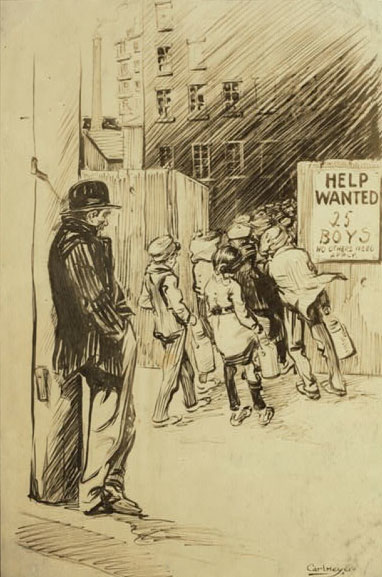
Cartoon, Child Labor, Library of Congress
As this cartoon insinuates, hiring children was cheeper that hiring an adult, thus encouraging two evils, child labor and adult unemployment.
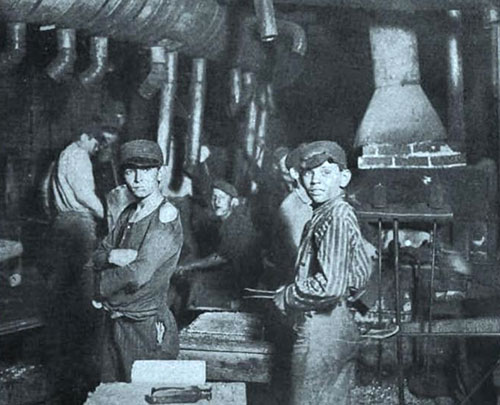
Child Labor Bulletin Vol 2
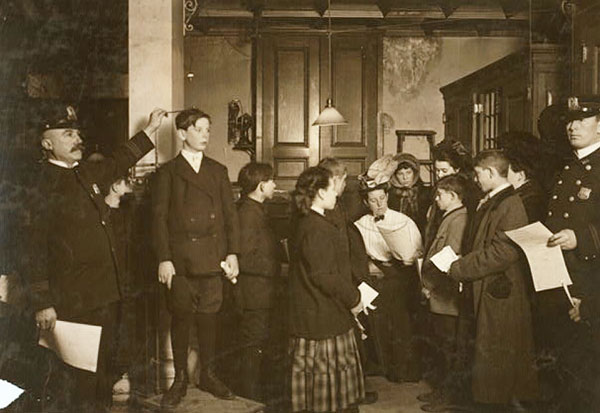
Getting Working Papers, New York, New York, Library of Congress
Child labor was particularly pernicious in glass works. See
Batch, Blow, and Boys: The Glass Industry in the United States, 1820s-1900
Woman in the Work Force
There were several instances of Red Hook women (either married or widowed)
running taverns, bars and/or
restaurants. Married women were also midwifes and wet nurses.
Widows were frequently janitresses, dress makers, seamstresses, laundresses, cooks and hat makers.
Single women worked in the Vaseline factory, garments shops, match factory, and the rope works.
Single women also were teachers, stenographers, telephone operators, sales girls, bookkeepers,
typewriters, cooks, nannies, chambermaids, cashiers, house keepers, waitresses, laundresses,
maids, servants, "Bonnaz operators" (lace mill), milliners,
neckware workers, feather curlers, artificial flower makers,
small machine operators (like braiding machines),
finishers, trimmers,
and piece workers.
In the late 1800 there were a lot of ads for "Figure Wanted" - showroom.
In general
the ads were looking for a "perfect 36 bust". It appears that the women were trying on
cloaks or
other clothing for clothing manufacturers. One ad from 1899 seeks: "FIGURE "WANTED -
36 bust; must be experienced. Peter Samuels, 112 Prince." Peter Samuels was a
manufacturers of fur cloaks.
If the censuses are any indication daughters of working class people worked in
some capacity until married. Most single women in their late teens and early
twenties worked outside the house in the late 1880 early 1900s in Red Hook.
Married women are VERY RARELY listed with an occupation in the census returns or in the city directories.
However it is presumed that many women must have helped their husbands in the shops and taverns.
A story reported in Hoboken tells of a women and her children who maintained
the family's tavern during the day while the husband worked in a factory.
In the evening the husband took over the running of the tavern. This was likely also true of business in Red Hook.
Widows, especially widows of small children, must have have had some type of
employment, even though most widowed women were listed with no employment in the censuses.
Quite a few widowed women were listed with occupations in the city directeries.
Women were employed at the Chesebrough Vaseline factory botteling Vasoline. See
Vaseline
Women were employed at Worthington after it had moved to Harrision, New Jersey where
they were employed as "core" makers and molders. I do not know if women worked
at Worthington while it was still in Red Hook. See Worthington
In an area near the waterfront some women must have earned their living a prostitutes.
In 1889 "A large number of Brooklyn girls work in New York, pay being higher than in Brooklyn and the industries more diversified."
Many "girls" commuted by ferry from Brooklyn to Manhattan.
There was apparently a separate women's cabin on the ferry as indicated by a story in January 1907.
A horse that had been pulling a wagon escaped his driver and found its way to the women's cabin.
The ladies fled to the men's cabin and no one was able to get the horse out of the women's cabin. Several men tried and finally one
enterprising young woman teased the horse out by offers of candy.
Some Red Hook Women who are know to have been employed outside the house:
-
Mathilda Ruppanner, born Prussia circa 1825 was a mid wife.
See Streets - 121 Coffey Street
- Dora Hammerstrom, a widow, ran a candy store at 121 Coffey Street. See Streets - 121 Coffey Street
- Meta de Groot, a widow, had a newsstand and cigar store at 382 Van Brunt.
See Streets - 382 Van Brunt
- Catherine Buse, the wife of Frederick Buse, had a candy store on Richards street.
See Streets - Richards street
- Mrs. DeMars, a widow, was instrumental in founding the Demars Kentucky Jean overall
factory on Van Brunt street. See Demars
-
Kunnigunda Siebe, a widow, ran a saloon on Ferris street in 1878.
See Siebe.
-
Frederika Barshaw was a junk dealer and owner of an iron foundry at 194 Conover. See
Streets - 194 Concover
-
In 1860 Mary Balfe the wife of John was a "store keeper"
She was listed in the 1865 City directory Balfe, Mary A., fancygoods, 499 Columbia.
In all other censuses she was listed as keeping house. See
Balfe
- Elizabeth Bell the wife of John ran a boarding house and eatery.
See
Bell
- Margaret Behnken was an interesting character.
See Behnken
- Margaret Brenner had a restaurant at 104 Van Dyke in 1891
See Red Hook Resaraunt owners
- Gesine Brickwedel took over the family liquor store after the death of her husband. See Brickwedel
- Annie Cassin the widow of Thomas ran a liquor store at 307 Van Brunt.
One son became a lawyer, another and insurance agent and her two daughters became
school teachers.
See Cassin
- Julia Collimore the widow of Michael had a liquor store. See Collimore
- Susan Dempsey sold oysters. See Dempsey
- How did Mary the widow of William Devan support herself and her young children?
See Devan
- Ann Ropke Deppermann the widow of Frederick ran the family saloon.
See Depperman
- How did Ann the widow of Thomas Doran support herself and her young children
after he was murdered in 1877?
See Doran
- Meta During the widow of Alfred had a newstand and candy store at 382 Van Brunt.
Meta Gough had a hat store at 382 Van Brunt. See Streets
- Julia Fay, widow of Lawrence, managed a hotel. See Fay
- Elizabeth (Betsey) Hart know as Aunt Betsey was acknowledged
as having owned and operated a restaurant at 21 Hamilton Ave. with her husband Benny.
See Red Hook Resaraunt owners
- Gesine Helke Groh was married first to Herry Helke and after his death to
Lorenz Groh. See Red Hook Resaraunt owners
- Ellen Kasserbrock ran a grocery store after her husband died in 1873.
See Kassenbrock
- Amelia Herganhan Kuhn and her husband Francis, the parents of artists Walt Kuhn,
ran a hotel that catered to ships and sailors.
Kuhn
- Ann O'Brien Costello had a saloon on Van Brunt.
O'Brien
- Phillipina Munsinger was left a widow with two small children. See
Munsinger
- Julia Mullady and her daughters were dressmakers. See Mullady
- Mary Murphy had a restaurant at 72 Van Dyke.
See Red Hook Resaraunt owners
- Margaret Murray was a saloon keeper after the death of her husband. See
Murray
- Ann Shea, the widow of Kieran Shea, ran a hotel at 448 Van Brunt.
Shea botom of the page.
- Anne Struck the widow of Herman ran a hotel on Van Brunt.
See Red Hook Restaurant owners
In 1897 at the Vaseline factory in Brooklyn "girls" worked an average of 59 hours a week.
There were at least two "working girls" clubs in south Brooklyn in 1890s:
The South Brooklyn club and the Red Hook club.
1889: Shop girls in Brooklyn worked from 7 till 9 every day except Saturday when
they worked from 7 to midnight and Sunday (when the stores were closed) they were expected to get the shop in order.
For this they earned $3 per week.
1891: First year primary grade teachers earned $300 a year. By year five
they could earn $575.
1894: 2 Dec. A woman in "South Brooklyn" was making "fine preserves".
She produced her goods in a three story house but was still unable to keep
up with the demands for her produce. A jar of her fruit cost $1.00 - twice the price of manufactured jams.
A woman in Flushing and another in College Point were producing "superfine " pickles.
Around the city other women were producing ketchup, mincemeat, vinegar, apple butter,
and pickled chillies. (The Sun, New York)
Ada C. Rehan and her sister, Kate, were stage actresses. They lived on Partition
(later Coffey street). See
Red Hook Celebrities
There were relatively frequent reports in the news papers of the
arrests of midwives for "criminal operations"
as a result of which the patients died. Another issue for midwives and physicians was not reporting a still
birth or death of a newborn.
Death in Ward 12 in 1875
The 1875 census indicates 20 deaths in the 4th district of Ward 12:
13 children under the age of 4 years and 7 adults.
The childhood deaths included: 2 young infants from inflammation of the lungs, one infant from spasms, 5
toddlers from diphtheria,
one 4 year old with inflammation of the lungs, 1 toddler with cholera "infantum",
1 toddler with water on the brain, 1 eight month old with convolutions, 1 two month old with cramps.
The adult deaths included: a 30 year old female with heart disease,
a 22 year old female with consumption (TB), a 46 year old female with consumption, a 50 year old male with dropsy,
a 51 year old male with heart disease, a 70 year old female with hemorrhage of the lungs,
and a 43 year old male with congestion of the lungs.
The 1875 Census indicates 16 deaths in the 5th district of the 12th ward: 14 children and 3 adults.
The childhood deaths included: 3 (ages 8, 5, and 3) from diphtheria,
1 three week old from "dispence", 1 two day old from anemia, 1 four
year old from measles, 1 three year old from croup,
1 one year old from brown Meatus??, 1 four month old from convolutions,
1 one year old from dropsy, 1 two day old from spasms, 1 eight month old from congested lungs,
1 four year old from mamonia ???, 1 six week old from inflammation of the bowls.
The adults deaths included: a 43 year old female from pneumonia and a 69 year old male cartman named Bernard Fox,
from "Injuries". Bernard Fox, age 70, who lived at the corner of Hicks and Huntington fell off
his truck which was loaded with molasses. The truck ran over him crushing his legs.
He died in the Long Island Hospital from his injuries. (BR)
The Brooklyn Eagle also indicates there was smallpox in Brooklyn in the summer of 1875.
Social Services
Day Care
In 1886 a day nursery was run by the Children's Home Industrial School of the Brooklyn Children's Aid Society at
139 Van Brunt across from the India Wharf. It contained a kindergarden for "very small
children" a sewing school and a day nursery for children under six years of age.
It was opened from 7 A. M. until 7 P. M. daily except Sunday.
It was housed in a plain red brick three story building with lots of windows.
In 1884 and 1885 ads were run in the Brooklyn paper looking for girls who
wanted to learn to sew on a
machine. 50 cents at the sewing machine school of the
Brooklyn Children's Aid Society.
How to Cool Off on a Hot Day
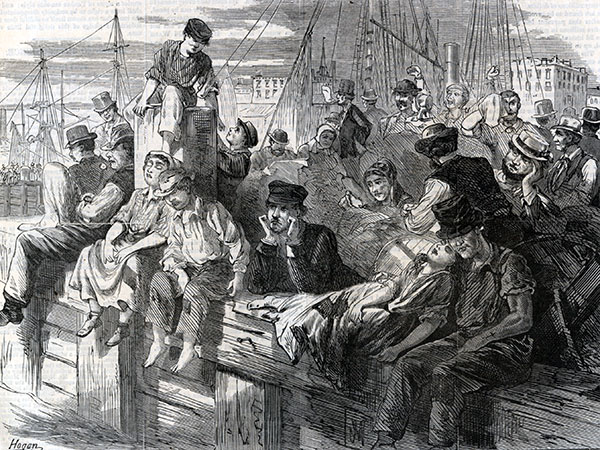
Harper's Weekly, August 22, 1868, collection of Maggie Land Blanck, July 2013
ON THE DOCKS AFTER A HOT DAY
People wore pretty much the same clothes winter and summer. Long pants and long sleeve shirts for men -
long skirts and long sleeve shirts for women. In summertime the shirt sleeves might be rolled up. And in the winter women
added more petticoats. In the winter people added more layers of the same type of clothing as they wore in the summer.
Notice, that as hot as it is, most of the men and women are wearing hats.
One might hope for a bit of breeze near the water's edge. There was no AC.
Floating Baths
In an attempt to clean the "great unwashed" floating baths were introduced in New York City in the early 1870s.
They were opened seasonally from June to October and were free to the public. The city considered them a means of providing cleanliness
whereas the local population considered them a means of recreation. Originally the water in the
baths was river water.
There were also private floating baths although I do not know if there were any in the Red Hook area.
On a hot summer day many men and boys would swim in the river in the nude.
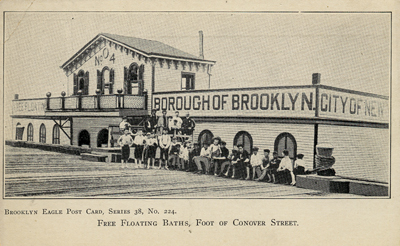
Postcard collection of Maggie Land Blanck
"Free Floating Baths, Foot of Conover Street" -
Brooklyn Eagle Post Card, Series 38, No. 224
In 1877 appointments were made in Brooklyn for a keeper, assistant keeper and matron for "the floating bath"
(no mention of locality). However, "The committee on Truant Home offered a resolution that the foot of
Reed and Conover streets be designated
as the permanent location of the new floating bath." (BE, May 1, 1877)
1879: Conover Street baths
September 25, males, 1,161, boys 1,800, women, 540, girls 726 total 4,-27
1883: June 11 - The residents
of the 12th ward were waiting patiently for the arrival of the free swimming baths at the fot of Conover street.
1885: Conover street baths admission for the week preceding July 27 -
Men 3,203; boys 12,209; women 1,117; girls 1,700
For the season up to that point - Men 18,860; women 5,163; boys 56,891; girls 11,350.
1885: Aug - Complaints were received in Mayor Low's office about Public Bath No 2
on
Conover Street.
The baths had been opened at irregular times on Sunday July 26 and Aug 2
when a charge of five cents was made for admissions to over 1150 people.
The money was received by the watchman. It was said the money
was a fee for towels and "tights".
The rules stated that a 10 cents deposit should be make for a towel
and that upon the return of the towel a seven cent
reimbursement would be made.
It was recommended that action be taken to prevent the opening of the baths at irregular hours.
1885: Bernhard Doherty, former keeper of the Public Bath no 2 at the foot of Conover Street,
went missing November 22, 1885. His body was found under a log in the river near the bath house,
on December 4 with
his watch in his hand and the time stopped at 2:47.
1889: Bath hours No. 2 Conover street: 5 A. M. to 9 P.M. week days
and 5 a. M. to noon Sunday.
July 1889: During the week prior to July 29, 1889 more than 32,000 men, women, boys and girls
had used the three city baths in Brooklyn. The highest usage was the Conover street baths.
July 1890: For the week ending July 20:
Bath No 2 foot of Conover, men 1,375, boys 5,200, women 800 girls 1,300.
August 1896: August 10, during the previous week 63,559 men, women, boys and girls
used the three Brooklyn public baths. "
The greatest number of people went
to the Conover street bath because "it is the only one in the Eastern district, nearly
forty thousand went there last week".
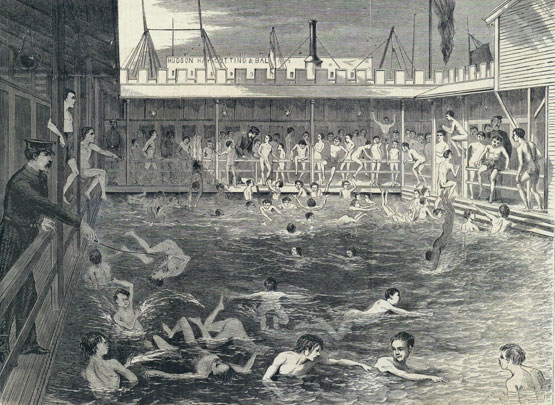
New York Historical Society - www.nyhistory.org - March 2013
"Interior of a Swimming Bath"
Legislation was passed in 1896 to establish a free floating bath in Brooklyn's sixth ward.
Brooklyn floating bath No. 4 was at the
foot of Conover street in September 1889 when a storm wave forced it against
the dock and caused some minor damage.
In 1905 there were five floating baths in Brooklyn: Foot of Noble Street, North First Street, Dock Street,
Conover Street, and 58th Street. The United States Volunteer Life Saving Corps gave free swimming lessons in all the free floating baths in
New York City.
In 1906 the bath at Conover street was
"towed to position" on June 11. It was still in existence at Conover street
in 1911. The baths closed in September.
In the 90 days the baths were opened at Conover street in 1905 they were used by 104,465 bathers.
The baths in Manhattan had separate days for men and women. I do not know if that was true in Brooklyn, but I would assume so.
Women of the ghetto bathing
- Library Of Congress
Work and Wages
Longshoremen made $2.50 a day in 1875 (per 1875 census)
In 1886 there was a strike for better wages. The longshoreman were asking for an increase in
wages from 20 cents and hour to 25 cents and hour.
Entertainment and Recreation
In 1895 after numerous lengthy delays it was announced
that Red Hook was to get a park. The designated site
was slightly larger than the present Coffey Park. It had been passed over by real estate developers
due to its "low marshy condition". It was also next to a smelly oil refinery and filled with industrial waste.
There are lots of indications that the local Red Hook population found many ways to amused themselves.
Frequently this involved excursions to parks in Brooklyn, Staten Island and
Queens. Trips to Coney Island.
Visits to Hoboken and Jersey City, New Jersey where drinking was allowed on a Sunday afternoon.
Ball Games
Baseball and cricket were popular pastimes for men and boys. Frequently church and work outings would involve a baseball game.
Picnics and Excursions
Most churches had an annual fundraising picnic in one of the parks in Brooklyn or Queens.
Some businesses also had annual picnics. A part of the outing often included an evening promenade.
Popular places were Pope's Park, the Schuetzen Park in Astoria, Bay View Park and Ulmer Park.
See excursions to parks below.
Excursions on barges and or steam boats were quite popular.
Dances - Balls
1891 February The Joppa Masquerade Largest Ball held at Saegerbund Hall this season: attendees Mr. and Mrs. A. W. Jayne, Mr. and Mrs Henry Hoehn.
See Hoehn
Music
William Struve, born circa 1873, the son of August Struve, grocery owner, became a musician.
He was referred to with both a band and an orchestra.
May 20, 1894 KNIGHTS OF ST. JOHN AND MALTA an evening of a wide variety of entertainment which included a "character
artist and mimic", a humorist, a comedian, a banjo solo, music by William Struve and more.
In 1895 William C Struve was listed as a organist.
November 26, 1898 KNIGHTS AND LADIES OF HONOR a ball on Thanksgiving eve at the Argyle by Defender Lodge enhanced
by colored electric light effects" and music by Professor Struve and the South Brooklyn Musical Glee club. There
were at least two grand marches.
1902 William Struve's ban enlivened the Fritzen Club outing.
Struve
Clubs and Organizations
- Fritzen Club
Fritzen Cluba social organization of south Brooklyn, "under the banner of Herman C Fritzen", held its annual
outing in 1902 at
Stimmel's Whitestone Park in Whitestone N.Y. The excursion left Hamilton Ferry on the
steamer, ISABEL with 500 on board. Professor Struves' band enlivened the "sail up the Sound". Sports included:
100 yard dash, 220 yard run, 440 yard run, half mile and one mile races, hurdles, and a baseball game. The base ball game was between the married men and the
single men. The bachelors won 6 to 4.
Mr. Fitzen presented the prizes.
April 12 1902 the Herman C. Fritzen Social Club of the Sixth Ward held its monthly "stag" at Carroll Hall, Carroll and Columbia streets,
There were vaudeville acts and refreshments. The Fritzen club had been organized the previous November and had a membership of 150.
- Carnation Social Club: held it second annual reception at the Weinlander academy February 1892.
- Knights of St. John and Malta:
- The Teutonia Saengerbund of South Brooklyn: held it annual ball at the Saengerbund Hall on Schermerhorn and
Smith Streets in November 1902.
- Gowanus Tern Verein:
- Brooklyn Quartet Club:
- Nordeutsch Schwestern:
- Humbold Quartet Club
- Indian Wharf Benefit Association
Societies
-
St Stephens Young Men's Union
-
The Irish Brigade
- Clan Na Gail
- Irish Societies
Irish Societies were invited to participate in the annual St. Patrick's day parade in 1879.
St. Patrick's Day was regularly celebrated with parades and dinners.
In 1883 at the 34th annual St. Patrick's day dinner 175 Irishmen celebrated at Mansion house. They
included George W Balfe, Peter J. Kelly,
Thomas Sheridan and James S Donovan.
See Blafe, Madigan/Kelly,
Sheridan, Donovan.
There were songs, speeches, toasts and a call for Home Rule.
Swimming
See floating baths above.
Young boys dove and swam in the waters around Red Hook.
Boat Races
Yacht races started out of Gowanus Bay.
Fishing
Crab, snapper, Lafayettes (a bright hued silvery fish), stripped bass and eels were caught off of Beard's Farm and by the Buttermilk Channel. Old times remember lobsters, oysters and mussels but by 1893 they were scarce.
Saloons
See Saloons in Red Hook
Preachers
In 1906 a Gospel ship was moored along the Red Hook Dock and crowds would attend the
services provided.
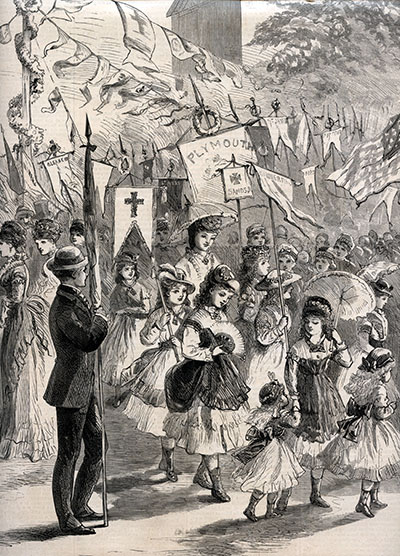
Collection of Maggie Land Blanck, July 2013
Brooklyn Sunday School Celebration - Harper's Bazar, June 20, 1874
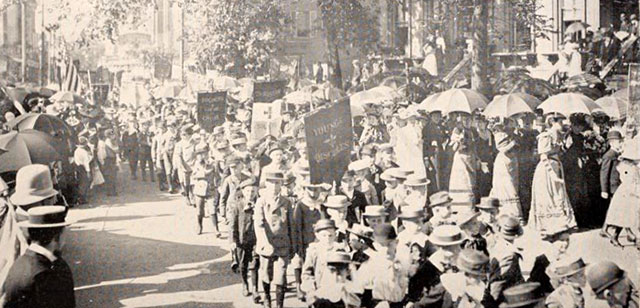
Leslie's History of New York Vol II Brooklyn
The Annual Brooklyn Sunday School Parade
Over 80,000 children marches in the sixty-eighth Sunday School
Parade in May 1897. In 1934 over 100,000 children marches.
The Sunday School Parade was still popular in the 1950s.
Brooklyn Visual Heritage
Excursions to Parks
Popular excursion destinations from Red Hook were to the Scheutzen parks in Astoria, Queens and Union City, New Jersey,
Pope's Park near Greenwood Cemetery, Ulmer Park at Gravesend, Koch's Bay View Park and Coney Island.
The church picnics usually involved games, such as egg races, relay races, standing leaps, running leaps,
and running races for men and boys.
Picnics for some organizations might involve ethnic music like harps, pipes and fiddles for the Irish societies, ump pah pah bands for the German
societies.
At the 1877 Visitation Church's fundraising picnic at Schuetzen Park several hundred children dressed in white with red ribbons
formed a parade. About 2,500 people attended despite the heat.
The very same day St. Mary Star of the Sea, another local church, had their fundraising picnic at Pope's Park.
The parks had "scups" (swings) and carousels.
Schuetzen Parks
Schuetzen Parks were found wherever there was a large German population.
See Union City, New Jersey
The "Union City" Schuetzen Park, at 3167 Kennedy Boulevard, North Bergen, NJ 07047-2303 is still in operation. Schuetzen Park
The Brooklyn Schuetzen Cops was founded in 1858. Schuetzenfests - competitive marksmanship events -
occurred frequently.
The Queens Schuetzen Park was at
1859 Myrtle Ave. Opened by at least 1858 the Myrtle Avenus Park in Glendale Queens
was reachable from Brooklyn via horse drawn streetcar
lines. The park contained a "hotel", dancing platforms, refreshment stands, beer gardens,
band pavilions, and a "shooting house" for rifle tournaments.
Pope's Park
Pope's Park in Brooklyn was reachable by the Bath & Coney Island Railroad and
Brooklyn cars to Greenwood, "about 6 minutes walk from Park". Located next to Greenwood cemetery on high ground it commanded a
beautiful view of the New York bay. As far as I can determine it was at 39th and 5th ave.
The park had a dance floor, dining saloons, rides (scups and swings), a shooting gallery, pavilions
Pope's Park was at one time managed by local
Red Hook politician, Tommy Sheridan .
In 1873 forty eight associations, churches and politicians had events
in Tommy Sheridan's Pope's Park.
In 1890 Old Pope's Park was turned into a car yard.
Koch's Bay View Park, New Utrecht
In 1897 the
park was located at Third Ave Corner of Sixtieth street, South Brooklyn (approximately where
the BQE and the Gowanus Expressway merge today).
Koch's Bay View Park boasted "a beer garden which specialized in picnic parties" and
a dancing platform.
The park also contained a shooting gallery and a spacious ball room.
Koch's Bay View Park was the setting for numerous, shooting events, galas, balls, barbecues, picnics, concerts
and song fests.
In July 1887 the Red Hook Rangers held their annual picnic at Bay View Park. "All of Red Hook turned out to attend and the park
was crowed to its utmost capacity".
In February 1890 an "Old German Pork Lunch" called metzelsuppe
took place in
Philip Koch's Bay View
Park. "Every dish that possibly can be made out of fresh pork was on
the table, together, of course,
with the inevitable sauerkraut, potatoes and other good things."
An "abundant supply of excellent Rhine wine" was also served.
In May 1888 the New Utrecht Police Board announced their intentions of
arresting flagrant violators of the Sunday laws who were dancing and playing ball in
Koch's Bay View Park.
Phillip Koch, age 71, proprietor of the Bay View Park, in South Brooklyn died in January 1894.
1870: Philip Koch 47, tavern keeper,
Elizabeth Koch 42
Elizabeth Koch 18
Philip Koch 16
John Koch 14
Wm Koch 12
Christy Koch 9
Morton Koch 6
1880 census:
Philip Koch 57, hotel keeper, Hesse Darmstadt,
Elizabeth Koch 54, wife, Hesse Darmstadt,
Philip Jr. Koch 26, bartender, Ohio,
William Koch 22, bartender, New York,
Christopher Koch 19, bartender, new York,
Martin Koch 16, bartender, New York,
Gabriel Denfel 33, hostler, Baden,
Gottlieb Schmidt 57, boarder, wollen dyer, Wurtenburg,
Thos. Cartwright 19, bartender, New York,
William Boehn 25, bartender, Bavaria,
Dora Brandt 17, servant, Bavaria.
1892:
Ulmer Park
Ulmer Park was a suburban resort "delightfully situated on the waters of Gravesend bay".
It was reachable by the Second avenue electric road. It had 680 feet of water front property.
It was divided into two sections, one north and the other south of
Twenty-fifth avenue, Unionville.
The northern section was called Ulmer Pavilion and the southern
section was called Ulmer Park. The two sections were connected by a boardwalk.
The Ulmer Pavilion was an immense building almost on the water. It contained an expansive dance floor.
Large orchestras played waltzes and two steps. In 1896 a stage was added in the pavilion to
put on vaudeville variety acts. The pavilion also contained a "first class" restaurant
and a large bar which served Ulmer beer.
North of the pavilion was a twenty feet wide pier which extended into the
water about 5 or 6 hundred feet.
There were: a bowling alley, billiard rooms, carrousel, steam swings (or scups),
and several shooting galleries. Swimming, bike racing, games of all sorts, rowing, fishing,
etc. were available.
There was a year round hotel.
Many societies, shooting clubs, singing clubs and other
organizations held their annual events at Ulmer Park.
The property was owned by William Ulmer, "one of the city's millionaire beer manufacturers"
and William Texter.
Coney Island
Coney Island was a popular day trip.
Linden Grove
Linden Grove on the Kill von Kull was a popular destination for barge excursions to Staten Island.
In August 1883 a large group of Red Hook Irishmen took their annual cruise to Linden Grove, in Staten Island,
below Elizabethport. Two large barges, the Walter Sands and the Excelsior, were towed by the
Moran tug, the George L
Garlick. They were joined by the new side-wheeled steamer Invincible and the Excelsior.
The crowd danced to a band of two Irish harps and a fiddle on The Excelsior and a similar
band on the Walter Sands.
At around 11 o'clock a brass band stated to play on the Walter Sands and there was
"noise and confusion and fun enough to satisfy the most boisterous Irishman".
The fleet finally set sail for the grove around noon and the day was "spent
in the enjoyment of such sports as usually characterize such occasions" Brooklyn Union August 6 1883
See Moran
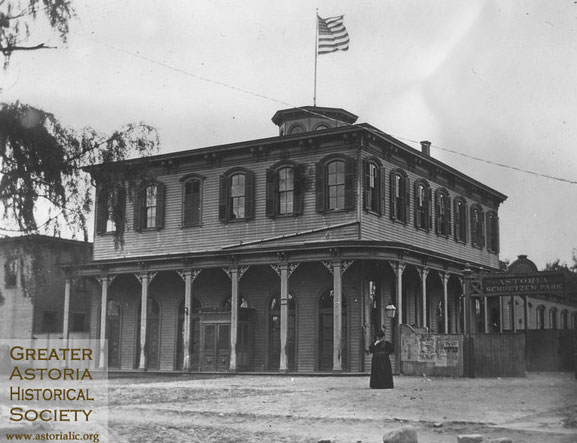
"Greater Astoria Historical Society" Quinn Building, 35-20 Broadway, 4th Floor
Long Island City, NY 11106
718-278-0700 Greater Astoria Historical Society Images
Astoria Schuetzen Park
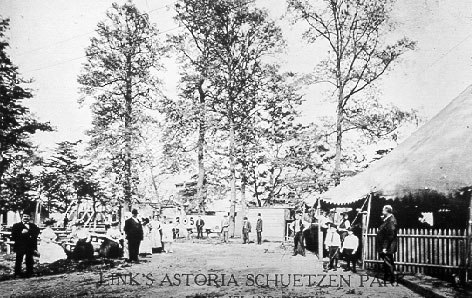
With permission of La Guardia and Wagner Archives,
La Guardia Community College, C.U.N.Y., July 2013 - "copyright 1910- Julius Link"
Astoria Schuetzen Park
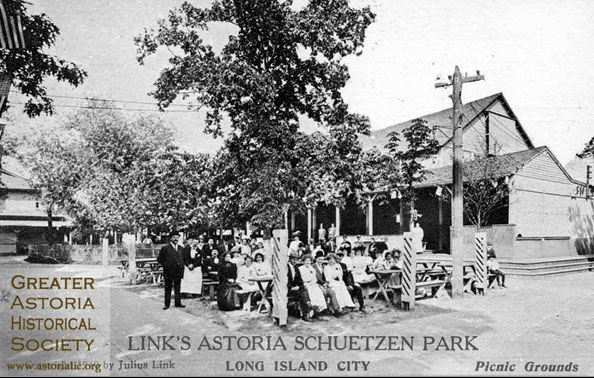
"Greater Astoria Historical Society" Quinn Building, 35-20 Broadway, 4th Floor
Long Island City, NY 11106
718-278-0700 Greater Astoria Historical Society Images
Schuetzen Park, Broadway and Steinway Street.
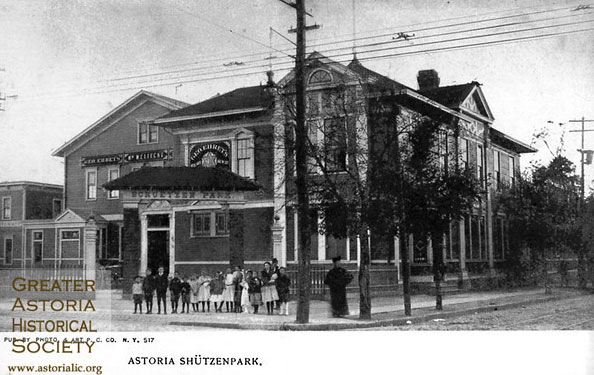
"Greater Astoria Historical Society" Quinn Building, 35-20 Broadway, 4th Floor
Long Island City, NY 11106
718-278-0700 Greater Astoria Historical Society Images
Astoria Schuetzen Park
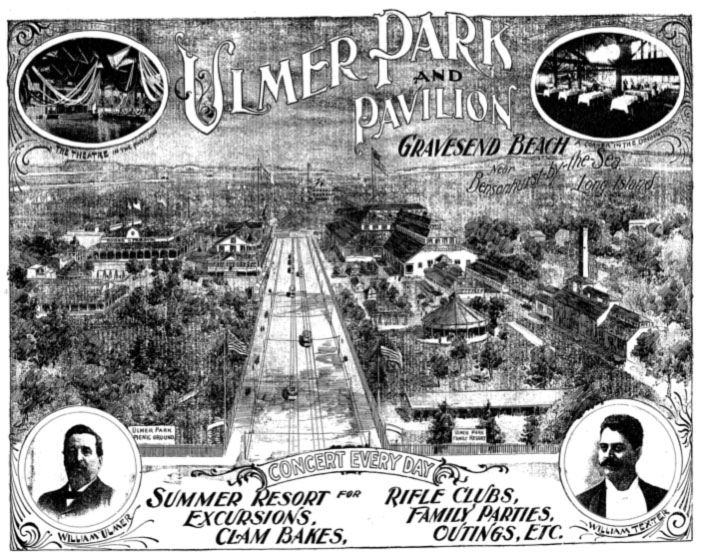
Brooklyn Eagle, June 14, 1896
Ulmer Park and Pavilion - looking towards the bay. The Belt Parkway now runs along the water at 25th
avenue.
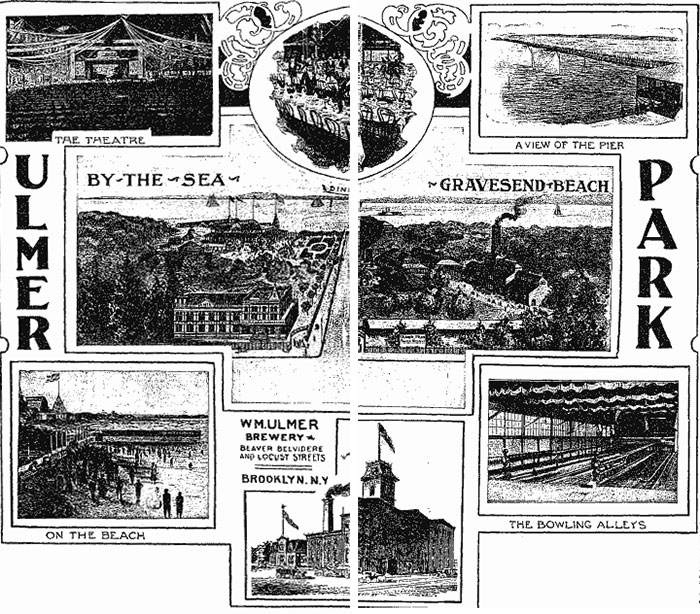
Brooklyn Eagle, June 17, 1900
Ulmer Park and Pavilion 1900
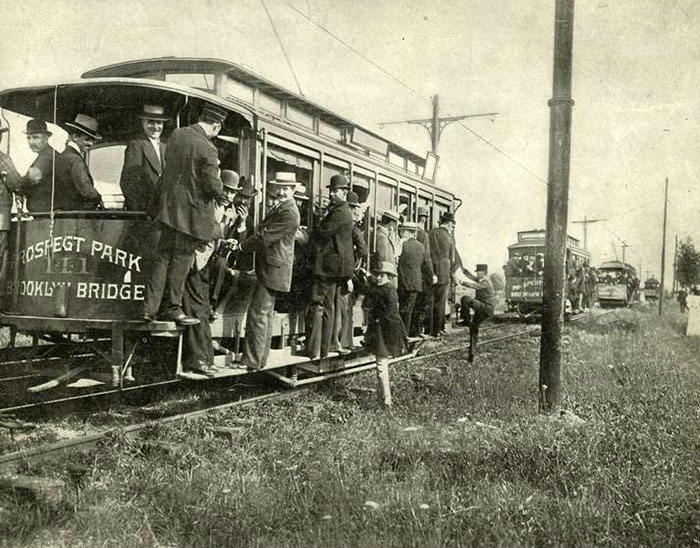
Image 809817 NYPL Digital collection, May 2013
A holiday crowd bound for Coney Island, Ulmer Park and Bath Beach. 1899
Railroads - Horse and Cable 1892
"Fares on all New York and Brooklyn surface horse and cable railways, five cents.
Children under five years of age free"
Brooklyn Railroads
Crosstown - From the Erie Basin, through Richards Street to Woodhull,
to Columbia, to Atlantic Avenue (South Ferry) to Court street,
to Joralemon, to Willoughby, to
Raymond street, to Park Avenue, to Washington Avenue, to Kent Avenue, to
Broadway (passing Grand and Roosevelt Ferries), to Driggs street, to Van C-- Avenue, to mNahattan Avenue, to Newtown Creek. Branch to Long Island
city, through Central Avenue at Broden Avenue to 34th Street Ferry and Long Island Railroad depot. Night cars
leave depots at 1:10, 1:30, 2;00 and 4;00 A.M.
Hamilton Avenue - From Hamilton Avenue Ferry through Hamilton Avenue thourhg 9th to Prospect Park
Hamilton Avenue _ From Hamilton Avenue Ferry through Hamilton Avenue to 3rd avenue
to 25th street to Greenwood Cemetery, connecting 3rd Avenue and 25th street for Fort Hamilton, Bay Ridge and Coney Island
(The World Almanac & Book of Facts, 1892)
There were connections at various places like Atlantic Avenue.
Water for the Thirsty
In July 1889 drinking fountains were set up around the city.
In Red Hook fountains were to be placed at Wolcott near Van Brunt and Richards near Van Brunt by mid August.
Ice was to be distributed free by a committee of temperate
citizens who believe it a good way to counteract the saloons and liquor dealers.
1894 AN UNPARDONABLE ACT
A conversation between two "Irishmen"
First Gowanusian - What's become o yer son. Jimmy? I haven't seen him for siveral weeks.
Second Gowanusian - I turned him out for disgracin' the family.
First Gowanusian - What did he do?
Second Gowanusian - He wint on the stage as a Dutch comedian!
The Irish did not think much of the German sense of humor.
|
